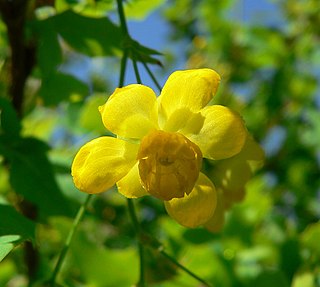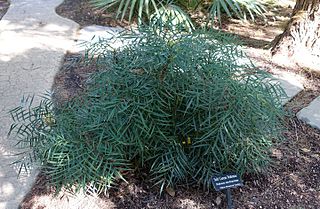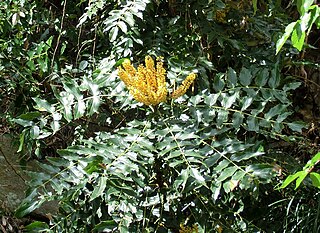
Mahonia is a formerly accepted genus of approximately 70 species of shrubs or, rarely, small trees with evergreen leaves in the family Berberidaceae, native to eastern Asia, the Himalaya, North America, and Central America. They are closely related to the genus Berberis and as of 2023 the majority of botanical sources list it as a synonym for Berberis.

Berberis trifoliolata is a species of flowering plant in the family Berberidaceae, in southwestern North America. Common names include agarita, agrito, algerita, currant-of-Texas, wild currant, and chaparral berry. The name Agarita comes from the Spanish verb agarrar, which means "to grab". The ending "-ita" is often added to little things, so agarita means "grabs a little". This was probably said because the bush is a bit scratchy but does not have significant spines. Typical characteristics are grey-green to blue-grey leaves, yellow flowers in February to April and the red berries appearing in May. The most important harvest organ are the berries, though the roots and seeds can also be used.
Berberis decipiens is a species of shrub in the Berberidaceae described as a species in 1913. It is endemic to Hubei Province in China. The species is listed as vulnerable by the IUCN.

Berberis fremontii is a species of barberry known by the common name Frémont's mahonia.

Berberis fortunei is a species of shrubs in the family Berberidaceae, the barberry family, described as a species in 1846. It is endemic to China, found in the provinces of Chongqing, Guangxi, Guizhou, Hubei, Hunan, Jiangxi, Sichuan, Taiwan, and Zhejiang. It is grown as an ornamental in many lands, with common names including Chinese mahonia, Fortune's mahonia, and holly grape.
Berberis chochoco is an evergreen shrub or small tree up to 9 m (30 ft) tall, in the genus Berberis, family Berberidaceae. It is native to mountainous regions of northeastern Mexico, in the states of Nuevo León, Veracruz, and San Luis Potosí.

Berberis gracilis is a plant species native to the Mexico, widely distributed from Tamaulipas to Oaxaca.

Berberis eurybracteata is a species of shrub in the Berberidaceae described as a species in 1901. It is endemic to China.
Berberis fordii is a species of shrub in the Berberidaceae described as a species in 1913. It is endemic to China, found in Chongqing and Guangdong Provinces.

Berberis gracilipes is a shrub in the family Berberidaceae, first described in 1887. It is endemic to China, native to the Sichuan and Yunnan Provinces.
Berberis longibracteata is a shrub in the family Berberidaceae, first described as a species in 1917. It is endemic to China, found in Sichuan and Yunnan Provinces.
Berberis monyulensis is a shrub in the family Berberidaceae first described as a species in 1961. It is endemic to Tibet.

Berberis napaulensis Nepali: जमाने मान्द्रो is a shrub in the family Berberidaceae described as a species in 1821. It is native to China and the Himalayas. This species is used medicinally throughout the Sikkim Eastern Himalayas.
Berberis schochii is a shrub in the Berberidaceae described as a species in 1913. It is endemic to China, known from the provinces of Guizhou and Sichuan.
Berberis polyodonta is a shrub in the Berberidaceae described as a species in 1901. It is native to Assam, Myanmar, and southwestern China.
Berberis paxii is a shrub in the Berberidaceae described as a species in 1901. It is endemic to the State of Hidalgo in eastern Mexico.
Mahonia zimapana is a shrub in the Berberidaceae described as a species in 1901. It is an uncommon species native to the States of Mexico and Hidalgo in Mexico.
Mahonia incerta is a shrub described as a species in 1901. It is endemic to eastern Mexico, known from the States of Hidalgo and Veracruz.
Berberis setosa is a shrub in the Berberidaceae described as a species in 1908. It is endemic to China, known from the provinces of Sichuan and Yunnan.
Berberis sheridaniana is a shrub in the Berberidaceae described as a species in 1913. It is endemic to China, found in the provinces of Hubei and Sichuan.







